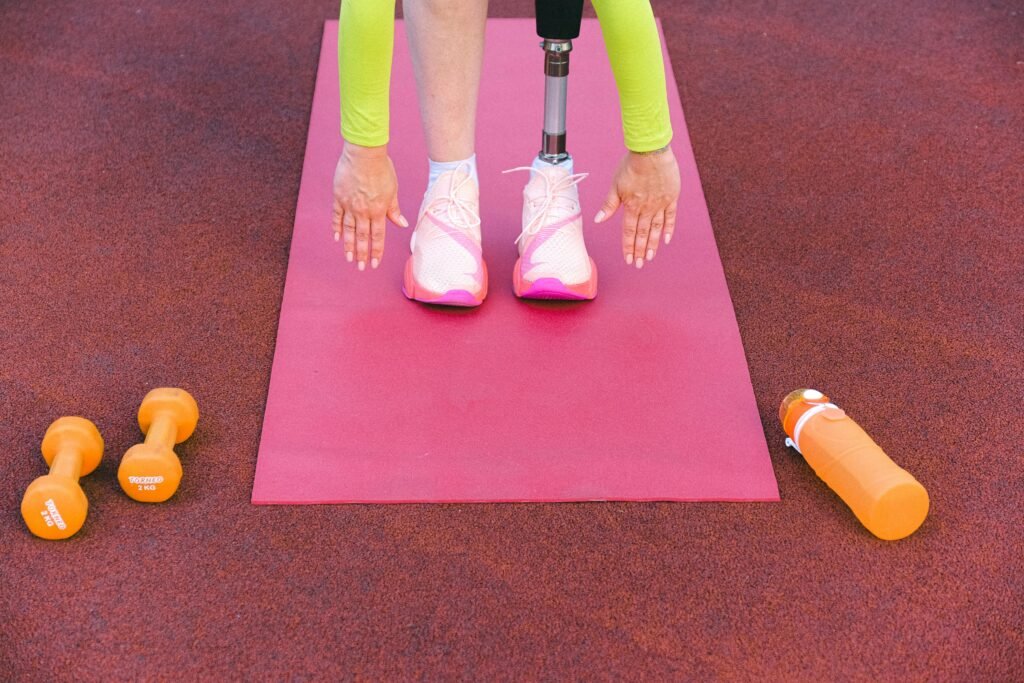
Whether you’re an athlete looking to improve your performance or simply someone who wants to maintain a healthy body, achieving flexibility through stretching is essential. In this article, we will explore various stretching techniques that can help you enhance your range of motion and prevent muscle injury. So, get ready to unlock the power of stretching and take your physical abilities to new heights!

This image is property of images.pexels.com.
Find more product like these on Amazon!
Importance of Flexibility
Flexibility plays a crucial role in maintaining overall physical health and well-being. When you are flexible, you have an improved range of motion, allowing you to move freely and effortlessly. Whether you are an athlete trying to enhance your performance or someone who wants to reduce the risk of injuries, incorporating flexibility exercises into your fitness routine is essential.
Improved Range of Motion
Having good flexibility means your joints and muscles can move through their full range of motion. This is important because it allows you to perform daily activities with ease. Whether it’s bending down to pick up something from the floor or reaching for a high shelf, being flexible makes these movements smooth and pain-free. Moreover, flexibility ensures that your body is prepared for various physical activities, preventing any limitations in movement.
Enhanced Performance
Flexibility is of utmost importance for athletes and individuals participating in physical activities. A flexible body allows for better sports performance as it enhances speed, agility, and overall athleticism. Improved flexibility helps in generating power for explosive movements, such as jumping or sprinting. It also aids in preventing muscle imbalances, which can lead to poor performance and even injuries. Thus, flexibility training should be an integral part of any fitness regimen, especially for those involved in sports or other physically demanding activities.
Reduced Risk of Injury
Stretching and flexibility exercises can greatly reduce the risk of injuries. When your muscles are flexible, they are less prone to strains and tears. Stretching helps to increase blood flow to the muscles, which improves their elasticity and reduces muscle tightness. This, in turn, reduces the likelihood of injury during physical activities or exercise. By incorporating stretching into your routine, you can help prevent common injuries such as sprains, strains, and muscle pulls.
Types of Stretching
There are various types of stretching exercises that can help improve flexibility. Understanding the different techniques will allow you to choose the most suitable ones for your needs.
Static Stretching
Static stretching is the most common and straightforward type of stretching. It involves stretching a muscle to its maximum and holding the position for a specific duration. This type of stretching is typically done at the end of a workout or physical activity to cool down the muscles. Static stretching helps improve flexibility by lengthening the muscles and increasing the range of motion.
Dynamic Stretching
Dynamic stretching involves moving your muscles and joints through a full range of motion. Unlike static stretching, dynamic stretching is performed with controlled and dynamic movements. It is typically done before a workout or physical activity to warm up the muscles and increase blood flow. Dynamic stretching helps improve flexibility, as well as enhance performance by stimulating the nervous system and preparing the muscles for activity.
PNF Stretching
PNF (Proprioceptive Neuromuscular Facilitation) stretching is a technique that combines passive stretching and muscle contraction. It is an effective method for increasing flexibility and improving muscle strength. PNF stretching involves a sequence of contraction and relaxation of the muscle being stretched. There are two commonly used PNF stretching techniques: Contract-Relax and Hold-Relax. Both techniques involve stretching a muscle to its limit and then applying resistance or holding the position before releasing tension. PNF stretching is often used in rehabilitation settings due to its ability to improve range of motion.
Static Stretching
Definition
Static stretching is a technique that involves stretching a muscle to its maximum length and holding the position for a specific amount of time. It is a safe and effective method of improving flexibility and increasing range of motion.
Techniques
To perform static stretching, choose a muscle group you want to stretch and move it into a comfortable position. Slowly and gently stretch the muscle until you feel a gentle pull or slight discomfort. Hold the stretch for 15 to 30 seconds, making sure not to bounce or jerk. Repeat the stretch two to four times on each side.
Benefits
Static stretching offers various benefits. It helps to elongate the muscles, improve their flexibility, and increase your overall range of motion. Regular static stretching can also alleviate muscle tension, reduce muscle soreness, and improve posture. Furthermore, static stretching can relax both the body and mind, making it an excellent practice for stress relief and relaxation.
Best Practices
To get the most out of your static stretching routine, follow these best practices:
- Perform static stretching after a warm-up or physical activity.
- Focus on major muscle groups such as hamstrings, quadriceps, calves, and shoulders.
- Breathe deeply and exhale as you relax into the stretch.
- Avoid bouncing or jerking movements, as they can lead to muscle strains.
- Maintain proper form and alignment while performing each stretch.
- Be consistent and include static stretching exercises in your regular fitness routine.
Dynamic Stretching
Definition
Dynamic stretching involves moving your muscles and joints through a full range of motion in a controlled and fluid manner. It is an active stretching technique that helps warm up the muscles and prepare them for physical activity or exercise.
Techniques
To perform dynamic stretching, choose a specific movement that mimics the activity you are about to engage in. For example, if you are going for a run, perform walking lunges or high knees to warm up the muscles. Move through each movement slowly and smoothly, gradually increasing the range of motion. Repeat each dynamic stretch for 10 to 12 repetitions.
Benefits
Dynamic stretching offers several benefits. It increases body temperature, heart rate, and blood flow to the muscles, preparing them for intense physical activity. Dynamic stretching also improves muscle coordination, agility, and joint mobility. Additionally, it enhances the functioning of the nervous system, allowing for optimal performance during sports or physical activities.
Best Practices
To maximize the effectiveness of your dynamic stretching routine, keep the following best practices in mind:
- Perform dynamic stretching before a workout or physical activity.
- Choose dynamic stretches that target the specific muscles or muscle groups you will be using.
- Start with smaller ranges of motion and gradually increase the intensity and speed of the movements.
- Focus on maintaining proper form and alignment throughout each dynamic stretch.
- Listen to your body and adjust the intensity or range of motion based on your comfort level.
- Stay hydrated during dynamic stretching, as it can be more physically demanding compared to static stretching.

This image is property of images.pexels.com.
PNF Stretching
Definition
PNF (Proprioceptive Neuromuscular Facilitation) stretching is a technique that combines passive stretching and muscle contraction. It involves stretching a muscle to its limit and then contracting the stretched muscle or its antagonist muscle group. PNF stretching is highly effective in improving flexibility, as it targets both the muscle lengthening and muscle strengthening components.
Techniques (Contract-Relax, Hold-Relax)
There are two common techniques used in PNF stretching: Contract-Relax and Hold-Relax.
In Contract-Relax, the muscle being stretched is contracted for a few seconds against resistance. After the contraction, the muscle is relaxed, allowing it to be stretched further. This process is repeated two or three times, gradually increasing the stretch with each repetition.
In Hold-Relax, the muscle being stretched is initially contracted for a few seconds against resistance. Instead of relaxing completely, a further isometric contraction is performed, enhancing the muscle’s flexibility. This technique is repeated two or three times, gradually increasing the stretch with each repetition.
Benefits
PNF stretching offers numerous benefits for flexibility improvement. It helps to increase both passive and active range of motion, making it particularly useful for athletes and individuals recovering from injuries. PNF stretching also enhances muscle strength and balance, reduces muscle imbalances, and improves overall muscle control and coordination.
Best Practices
To engage in safe and effective PNF stretching, consider these best practices:
- Consult with a trained professional or therapist to learn the proper techniques and guidelines.
- Warm up your muscles before performing PNF stretches to increase their pliability.
- Use a partner or resistance equipment to provide the necessary resistance during PNF stretching.
- Gradually progress by increasing the intensity and duration of each contraction and stretch.
- Listen to your body and avoid pushing beyond your comfort level or experiencing pain.
- Incorporate PNF stretching into your regular fitness routine to maximize flexibility gains.
Stretching Routine
Warm-up
Before starting your stretching routine, it is crucial to warm up your muscles. A warm-up can be as simple as performing light aerobic exercises such as jogging, jumping jacks, or cycling for 5 to 10 minutes. Increasing your body temperature and blood flow helps reduce the risk of injury during stretching and prepares your muscles for the upcoming stretches.
Targeted Muscle Groups
When creating your stretching routine, it is important to focus on all major muscle groups. This includes stretching your hamstrings, quadriceps, calves, glutes, chest, shoulders, and back. By targeting these areas, you ensure a well-rounded stretching routine that addresses flexibility in the entire body.
Duration and Frequency
The duration and frequency of your stretching routine depend on your personal goals and schedule. Aim to hold each stretch for 15 to 30 seconds, repeating two to four times on each side. For optimal flexibility benefits, perform stretching exercises at least three times a week. However, if you are actively involved in sports or have specific flexibility goals, daily stretching may be more beneficial.
Cool-down
After completing your stretching routine, it is vital to cool down your body. Perform low-intensity cardiovascular exercises for 5 to 10 minutes, such as walking or gentle cycling. Cooling down helps gradually bring your heart rate and breathing back to normal, prevents dizziness or lightheadedness, and allows your muscles to relax and recover.

This image is property of images.pexels.com.
Flexibility Training Aids
To further enhance your flexibility training, consider incorporating the use of various training aids.
Resistance Bands
Resistance bands are inexpensive and versatile tools that can be used for stretching exercises. They provide resistance as you stretch, allowing for a deeper and more effective stretch. Resistance bands come in different levels of resistance, making them suitable for individuals of all fitness levels. They can be used to target various muscle groups and increase overall flexibility.
Foam Rollers
Foam rollers are cylindrical foam tools used to perform self-myofascial release techniques. Rolling different muscle groups on the foam roller helps release tightness and tension, improving flexibility and reducing muscle soreness. Foam rollers are particularly beneficial for targeting large muscle groups, such as the quadriceps, hamstrings, IT band, and back muscles.
Stretching Straps
Stretching straps are adjustable straps that assist in stretching various muscle groups. They provide support and help increase flexibility by allowing you to reach further into stretches. Stretching straps can be used for both static and dynamic stretching exercises, making them a versatile tool for improving flexibility.
Incorporating Yoga for Flexibility
Yoga is an ancient practice that combines physical postures (asanas), breathing techniques (pranayama), and meditation. It not only improves flexibility but also promotes mindfulness, relaxation, and overall well-being.
Overview of Yoga
Yoga incorporates various poses and movements that target different muscle groups. These poses gently stretch and strengthen the body, enhancing flexibility and improving posture. The mindful breathing techniques used in yoga help calm the mind and reduce stress, creating a harmonious balance between the body and mind.
Specific Yoga Poses for Flexibility
Certain yoga poses are particularly effective in enhancing flexibility. Poses such as Downward Facing Dog, Forward Fold, Triangle Pose, Pigeon Pose, and Bridge Pose target the muscles in the legs, hips, back, and shoulders. By practicing these poses regularly, you can gradually increase your flexibility and enjoy the many benefits of yoga.
Benefits of Yoga in Enhancing Flexibility
Yoga offers numerous benefits for flexibility improvement. The combination of stretching and strengthening exercises in yoga helps lengthen muscles, increase joint mobility, and improve overall flexibility. Regular practice can also alleviate muscle tension, improve balance and stability, and enhance body awareness. Moreover, yoga promotes relaxation and reduces stress, making it an excellent addition to any flexibility training routine.
Common Mistakes in Stretching
To ensure a safe and effective stretching practice, it is important to avoid common mistakes that can lead to injury or hinder flexibility progress.
Skipping the Warm-up
Skipping the warm-up before stretching can increase the risk of muscle strains or pulls. A proper warm-up increases blood flow to the muscles and prepares them for stretching. Spend a few minutes performing light aerobic exercises to raise your body temperature, increase blood circulation, and make your muscles more pliable.
Bouncing or Overstretching
Bouncing or performing jerky movements during stretching can lead to muscle strains or tears. It is important to stretch slowly and gently, avoiding any sudden or forceful movements. Gradually ease into each stretch, and if you feel pain or discomfort, reduce the intensity or stop the stretch altogether.
Holding the Breath
Holding your breath while stretching can restrict oxygen flow to the muscles and increase tension. It is essential to breathe deeply and naturally during stretching exercises. Inhale deeply before starting the stretch and exhale as you relax into the stretch. Focus on maintaining a steady breath throughout each stretch to promote relaxation and ease tension.
Neglecting Muscle Imbalances
Muscle imbalances can hinder flexibility progress and increase the risk of injury. It is important to address any muscle imbalances by incorporating stretches that target both the stronger and weaker muscle groups. By stretching all muscles evenly, you can improve muscle balance, posture, and overall flexibility.
Additional Tips for Safety and Effectiveness
To ensure safety and maximize the effectiveness of your stretching routine, follow these additional tips:
Listen to Your Body
Pay attention to your body and listen to its signals. If a stretch feels uncomfortable or causes pain, ease off or modify the stretch. Remember that stretching should be a gentle and gradual process, and forcing your body beyond its limits can do more harm than good.
Gradual Progression
Flexibility gains do not happen overnight. It is important to progress gradually and not push yourself too hard. Start with easier stretches and gradually increase the intensity or duration as your body becomes more flexible. Consistency is key, and over time, you will notice significant improvements in your flexibility.
Proper Breathing Technique
Breathing properly during stretching is essential for relaxation and optimal effectiveness. Take slow and deep breaths, inhaling through your nose and exhaling through your mouth. This helps oxygenate your muscles, relaxes the body, and allows for a deeper stretch. Focus on syncing your breath with the movements to enhance the mind-body connection.
Seek Professional Guidance
If you are new to stretching or have particular flexibility goals, it is recommended to seek professional guidance. A fitness instructor, physical therapist, or certified yoga instructor can provide personalized guidance and ensure that you are performing the stretches correctly and safely. They can also create a customized stretching routine tailored to your specific needs.
Incorporating flexibility exercises into your fitness routine is not only important for athletes or enthusiasts but for everyone. Improved flexibility enhances your quality of life by allowing you to move freely, reduce the risk of injuries, and enhance your overall physical performance. By understanding different stretching techniques, following best practices, and making flexibility training a regular part of your fitness regimen, you can unlock the benefits of a flexible body and enjoy a healthier, more active lifestyle.

